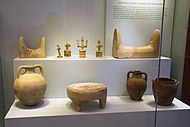Horns of Consecration

"Horns of Consecration" is a term coined by Sir Arthur Evans[1] for the symbol, ubiquitous in Minoan civilization, that is usually thought to represent the horns of the sacred bull. Sir Arthur Evans concluded, after noting numerous examples in Minoan and Mycenaean contexts, that the Horns of Consecration were "a more or less conventionalised article of ritual furniture derived from the actual horns of the sacrificial oxen".[2]

The much-photographed porous limestone horns of consecration on the East Propyleia at Knossos (illustration, right) are restorations, but horns of consecration in stone or clay were placed on the roofs of buildings in Neopalatial Crete, or on tombs or shrines, probably as signs of sanctity of the structure.[3] The symbol also appears on Minoan sealstones,[4] often accompanied by double axes and bucrania, which are part of the iconography of Minoan bull sacrifice. Horns of consecration are among the cultic images painted on the Minoan coffins called larnakes, sometimes in isolation; they may have flowers between the horns, or the labrys.[5] It is generally agreed to be something to do with Minoan religion.
Sites
[edit]Minoan sites where the horns have been found in some form include Archanes, Armeni, Kamilari, Knossos, Mount Juktas, Odigitria, and Tylissos.
Astronomy
[edit]A suggestion for a practical use for the large examples on the top of buildings, is that they were used as frames for sighting the movements of heavenly bodies, for example the constellation of Orion, which may have represented the "young god" of Minoan religion.[6]
Comparisons
[edit]Evans compared the Horns of Consecration with the four "horns of the altar" of Hebrew ritual,[7] and with the altar with a horned cult object depicted on the stele from Teima in northern Arabia, now conserved at the Louvre.[8]
-
Miniature fresco fragment, Knossos
-
From shrines on Crete, Postpalatial period, AMH
-
topping a tomb on the Hagia Triada sarcophagus
-
Crowning terracotta goddess figure, Gazi, 1300-1100 BC, AMH
Notes
[edit]- ^ E..g. in Evans, "Mycenaean tree- and pillar-cult and its Mediterranean relations", The Journal of Hellenic Studies 31 (1901) pp 107, 135-38, "§15- The Horns of Consecration".
- ^ Evans 1901:137; horns of consecration are juxtaposed with bulls in many configurations on Late Minoan IIIA2 larnakes illustrated by L. Vance Watrous, "The Origin and Iconography of the Late Minoan Painted Larnax" Hesperia 6.3 (July 1991), pp 285-307).
- ^ Geraldine C. Gesell, Town, Palace, and House Cult in Minoan Crete (SIMA, Göthenburg) 1985, p. 62.
- ^ An example is the seal illustrated by Evans, "The Palace of Knossos", BSA 7 (1900/01), fig. 9 and as fig. 1 in Karl Kerenyi, Dionysos: Archetypal Image of Indestructible Life (Princeton) 1976, and by Joseph Campbell, Occidental Mythology: The Masks of God (1964) 1970, fig. 12.
- ^ Watrous 1991, passim.
- ^ MacGillivray, Alexander, and Hugh Sackett. “The Palaikastro Kouros: the Cretan God as a Young Man”, p. 168-166, Chapter 14 of The Palaikastro Kouros, a Minoan Chryselephantine Statuette and its Aegean Bronze Age Context", British School at Athens Studies, vol. 6, 2000, pp. 165–169. JSTOR. Accessed 22 Feb. 2021
- ^ Their special sanctity is reflected in the practice of the sanctuary seeker clasping the horns of the altar (1 Kings i.50; ii.28ff, noted in this context by Richard Broxton Onians, The Origins of European Thought About the Body, the Mind, the Soul, the World, Time and Fate 2nd. ed. (1988) p. 236 note 9.
- ^ Evans 1901:137 fig. 20.




